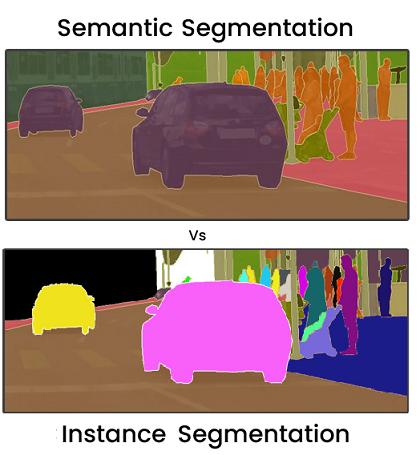Infosearch BPO offers both instance segmentation and semantic segmentation, as well as other data annotation services. Contact us for any of your requirements.
Instance segmentation and semantic segmentation are two significant methodologies that belong to the computer vision field, especially in the field of image and video processing. They are meant to be used as a tool for segmentation and recognition of various segments in an image; however, they operate in distinctly different ways and provide very distinct functions.
Semantic Segmentation
Semantic segmentation is the use of an image to label all the pixels that are present in the picture. This means that every pixel on the picture, including the roads, the cars, the trees, etc, are classified into a certain category.
How It Works:
The algorithm assigns a label to each pixel of the image, disregarding for instance, the different instances of the object in the image. For instance, if there are several cars in the image, then semantic segmentation will mark all the image pixels to which cars belong as “car” but will not mark which cars are exactly this or that car.
Use Cases:
Autonomous driving: Classification of road, sidewalks, vegetation, etc.
Medical imaging: Understanding the difference between tissue types.
Satellite imagery: Such things as forests, water bodies, and the built-up areas, which include the urban areas.
Advantages:
More straightforward and requires fewer calculations compared to the instance level.
Effective for use in scenarios where extraction of one object from another type of object belonging to the same category is not crucial.
Limitations:
Can not differentiate between two objects belonging to the same class (e. g. , cannot differentiate between two cars in a parking lot).
Instance Segmentation
Instance segmentation is more advanced than semantic segmentation, as it not only labels all the pixels, but also goes further to differentiate between different types of the same type. In other words, it divides it into individual classifications of objects, or, as we term it, particularizations of a category.
How It Works:
The algorithm assigns each pixel a class label, and an instance label is also assigned. For example, if there are three cars in an image, each car will be segmented as a different object, and each object will have a label of its own.
Use Cases:
Object detection in autonomous vehicles: identification of single pedestrians, cars, barriers, or objects to identify them as such.
Robotics: To perform the test, objects were placed haphazardly in the workspace, and the subject was required to pick on specific items out of the clutter.
Image editing: It is possible to isolate the objects to be enacted for manipulation of each one individually.
Advantages:
Is a more refined idea of the image by giving a certain differentiation of objects whose nature can be recognized.
It is especially beneficial in such activities when points should be distinguished that belong to the same class.
Limitations:
Heavier and computationally more intensive than semantic segmentation.
Is more sensitive to the quality of the chosen models and the size of training data sets.
Key Differences
Purpose:
Semantic Segmentation: Assigns each pixel to a certain category but is incapable of differentiating within that category.
Instance Segmentation: Labels each pixel but it also recognizes various occurrences of similar types of pixels.
Complexity:
Semantic Segmentation: Easier and quicker, which is employed in cases in which the differentiation of individual occurrences is unnecessary.
Instance Segmentation: This is more complex and requires more computing power than simple SVM to deal with objects, where the particularity is important.
Output:
Semantic Segmentation: Operates, for each pixel, one class label.
Instance Segmentation: Generates per pixel both a class label and an instance identifier.
Conclusion
There are two types of segmentation in computer vision: semantic segmentation and instance segmentation, and both are quite useful depending on the type of segmentation problem that an application or user wants to solve. Semantic segmentation can be used in scenarios where the general organisation of a scene matters more than the ability to differentiate between objects. Instance segmentation, on the other hand, is very important when concentrating on certain objects in the scene, such as in self-driving cars or robotics. Thus, the choice between the two depends to a considerable extent on the peculiarities of the given task.








Recent Comments